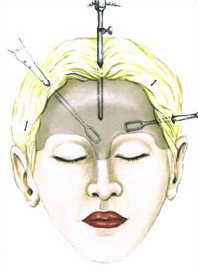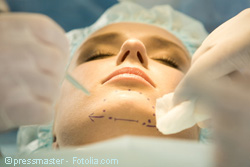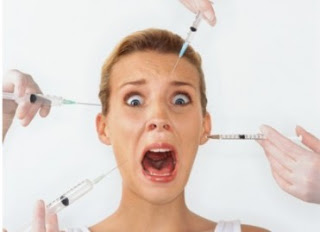How to Recover Faster After Plastic Surgery
Lymph Treatment (Manual Lymph Drainage) provides non-invasive and natural pain relief after an eye or brow lift surgery, rhinoplasty, vertical or lower facelifts, liposuction or tummy tucks, as well as breast reduction or implant surgery.
Less Pain, Less Swelling, Less Bruising, Less Scar Tissue, Faster Recuperation
Unfortunately, too many massage therapists claim to be able to perform lymphatic massage or Manual Lymph Drainage (MLD) after having taken a short “Weekend Seminar”. Though they may be well trained in more common massage modalities like Swedish or Deep Tissue massage, their lack of knowledge of MLD, cosmetic surgery procedures, and experience in working with post-surgery patients may potentially cause severe problems with your surgery outcome.
Thus, it is imperative you check their credentials in Manual Lymph Drainage; you wouldn’t want them to pull internal stitches or cause more inflammation and swelling, which would equal more pain, much slower recuperation, more scar tissue, and maybe even a trip back to your surgeon.
So, where do you find a qualified practitioner who not only has been extensively trained in the medical massage modality of Manual Lymph Drainage (at least 100 hours, as this includes advanced classes), but also has experience with pre-and post-surgical procedures, as well as knowledge of the newest procedures in the field of cosmetic surgery?
There are not very many massage therapists who are actually Certified Lymphedema Therapists (though of course, there are some…yours truly included); mostly you will find Physical Therapists and nurses, however, not all PTs are certified in MLD. Good places to check for qualified therapists are the MLD schools. I have included links to their list of graduates at the bottom of this blog. Call them up, and ask specific questions about their experience with cosmetic surgery.
A reputable therapist will be able to give you detailed information, maybe have some references (though many patients prefer not to be named, and the HIPPA confidentiality laws are binding).
Another source of information and referral could be your plastic surgeon’s office. They may have a certified MLD therapist on staff or have a referral list.
Remember: “The best outcome of any cosmetic or plastic surgery lies in the hands of your physician, the condition of your skin and tissues before surgery, as well as the care and maintenance you give your body afterward.”
http://www.klosetraining.com/TherapistDirectory.asp
http://www.vodderschool.com/find_a_therapist
http://www.nortonschool.com/therapistreferrals_form.html
http://acols.com/FindaTherapist.aspx
http://www.lymphnet.org/resourceGuide/findTreatment.htm
August 2013
A little primer on endoscopic face lifts, its after effects, and how to treat those
by Ingrid Marsten, C.L.T. – SPECIALIZING IN POST-COSMETIC SURGERY
Endoscopic facelift are often called “scar-less facelift” because, rather than using longer incisions in the skin of the face and neck, they involves only a few one-inch-long incisions in the skin. These incisions are usually made in the skin above the hairline or behind the ears, allowing them to remain virtually out of sight. Nonetheless, it is surgery! Just because you don’t have the outside scars (and don’t have the whole face “pulled”) doesn’t mean all is always easy and painless.
 In the lower face/neck lift, theplastic surgeon removes excess skin on the neck through a small incision behind the ear and the back of the scalp. Sometimes, there might be an additional incision in front of the ear, but mostly, plastic surgeons try to avoid cutting or minimize the cutting in that area when doing and endoscopic face lift. Besides doing some lipo on the neck/chin, the physician might actually use fat transfers to the area of the cheeks to compensate for the natural loss of fat, which is responsible for the “drooping jowl effect”. Yes, you might have to donate some of the belly fat ;)
In the lower face/neck lift, theplastic surgeon removes excess skin on the neck through a small incision behind the ear and the back of the scalp. Sometimes, there might be an additional incision in front of the ear, but mostly, plastic surgeons try to avoid cutting or minimize the cutting in that area when doing and endoscopic face lift. Besides doing some lipo on the neck/chin, the physician might actually use fat transfers to the area of the cheeks to compensate for the natural loss of fat, which is responsible for the “drooping jowl effect”. Yes, you might have to donate some of the belly fat ;)
An additional (horizontal) incision under the chin may be required, as well as neck liposuction. This horizontal scar is important to the tightening of the tissues under the chin, however, it also creates a “physical barrier”, and makes it more difficult to drain the cellular debris and swelling from this area to the lymph nodes under the chin. Often, the scar becomes hardened and this occasionally can cause discomfort (I call it the “Boa constrictor” effect).

It is important to know that massaging this scar needs to be done in an extremely gentle manner. The scar needs to soften a bit; rubbing it too firmly can cause inflammation and further damage to the tissues, which might require a trip back to the surgeon.
I have done numerous successful lymphatic treatments on lower face/neck lifts, and it almost always helps tremendously with softening the scars and alleviating the discomfort. Unlike pain pills, lymphatic treatments work on the cause of the problem – not by masking it, but by helping the body to heal faster.
Activating the lymph nodes in the chin and re-routing the fluids can help heal much faster. I usually start this work about 2 weeks after the surgery; HOWEVER, even older scars can be softened through this exclusive lymphatic treatment.
April 22, 2022 - revised and updated
Reduce Bruising and Swelling after Botox® and Fillers
Discretion is imperative in my business!
According to the American Society for Aesthetic Plastic Surgery, in 2019, Americans spent more than 5 billion dollars on injectables like Botox®, Juvaderm® or Restalyne® alone.
Most of the times, there is absolutely no downtime, however in some cases, there can be Bruising and Swelling around the mouth, eyes, or neck, which may take anywhere from 1 to 2 weeks to disappear. Of course you can try to cover those bruises with concealer and mineral powder foundation, however, what if you have to be in public?
As a Lymphatic Therapist, specializing in cosmetic surgery, and working with foremost plastic surgeons and dermatologists, as well as facialists and make-up artists, I count amongst my patients and clients several well-known actors and public figures. And YES, there have been some “injection bruises”, and frantic phone calls/texts because the client had to be in front of the camera within 4 days.
“Can you please come over, Ingrid? I have to be on camera in 4 days and have bruises around my mouth and eyes. There can be absolutely NO trace of this left by Friday…..”
You don’t have to be an actress or rock star; I can help reduce bruising and swelling from Botox injections or fillers through a gentle, non-invasive signature lymphatic treatment. Unfortunately, we have to wait 5 days before doing facial lymphatic drainage, as we could potentially be "moving" the Botox (and cause a droopiness in your eyes or face). After the 5-day waiting period, it is safe and beneficial to receive MLD on your face and neck.
Depending on the amount of bruising, I can speed up the healing time by 50%-75%! Instead of 2 weeks, you may be free of bruises within 3 to 4 days.
IMPORTANT INFORMATION: Do not get lymphatic massage or any facial treatments for at least five (5) days after neurotoxin injections Like Botox, Dysport, Xeomin, or Jeuveau! They could be moved, and you might end up with droopy eyes or other strange looking effects for several months, and unfortunately, those cannot be ameliorated.
Fillers or fat transfers also should not be worked on for at least 5 days.
Please feel free to call/text or email me.


